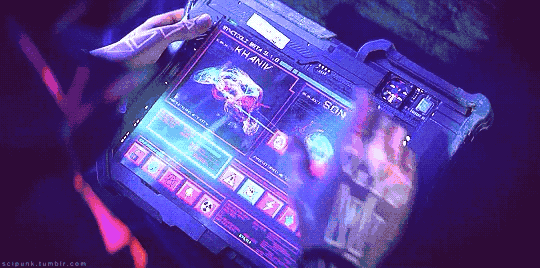#brain computer interfaces
Explore tagged Tumblr posts
Text

41 notes
·
View notes
Note
15 for the ultra-processed disability ask thing!
Ok for reference that's
What’s something your disability has stopped you from learning or doing?
Fun story!
For my Ph.D. I studied brain computer interfaces. Specifically P300 brain computer interfaces. Here's my dissertation, for reference.
As far as I can tell, most people studying brain computer interfaces will ever use them. It might not be for their own communication needs (I'm a a part-time AAC user but I do just fine using my hands to access my AAC; I don't need a brain computer interface.) But if you work in a lab with brain computer interfaces, you're probably going to get called on to test that, like, new settings do what they say they do / that it's still possible to make selections / that the data collection method actually collects the data by using the interface. Plus we get tapped to be "neurotypical controls" (what my papers say) and/or "healthy controls" (what a lot of other people's papers say; I've also seen people alternate between the two) on a semi-regular basis, if we're close enough on whatever other demographics they're matching on to be reasonable.
I'm obviously not a neurotypical control. But I also cannot use a P300 brain computer interface, because that's basically dependent on flashing lights a bunch of times per second. So I got a Ph.D. studying a kind of brain computer interface that I cannot use.
(There are other kinds, some of which I can use. One particularly desperate masters student working with motor imagery brain computer interfaces tried to change his thesis wording to "controls without Parkinson's" so he could use me as a control. Pretty sure his supervisors made him take me back out though; his final thesis says both neurotypical control and healthy control.)
5 notes
·
View notes
Text
Looking for enhanced Neurofeedback EEG Device? Simply approach g.tech medical engineering GmbH! With our devices, you can do real-time data analysis. For more information, you can visit our website https://www.gtec.at/ or call us at +43 7251 22240
0 notes
Text
Love how they're desperately trying to downplay Neuralink even as they admit it has advantages that, as far as is publicly known, no other version of this tech does. This tech has the potential to give countless people their lives back, but we've gotta dilute that message because it's more important that people not think anything positive about Elongated Muskrat.
#elon musk#elongated muskrat#neuralink#neural interface technology#brain computer interfaces#brain computer interface market
1 note
·
View note
Text
Theater of Thought
Director: Werner Herzog Year: 2022 Distributor: Skellig Rock
More information: Theater of Thought — The Neurorights Foundation
0 notes
Text
Wed 12 May 2021 16.00 BST
0 notes
Text
why neuroscience is cool
space & the brain are like the two final frontiers
we know just enough to know we know nothing
there are radically new theories all. the. time. and even just in my research assistant work i've been able to meet with, talk to, and work with the people making them
it's such a philosophical science
potential to do a lot of good in fighting neurological diseases
things like BCI (brain computer interface) and OI (organoid intelligence) are soooooo new and anyone's game - motivation to study hard and be successful so i can take back my field from elon musk
machine learning is going to rapidly increase neuroscience progress i promise you. we get so caught up in AI stealing jobs but yes please steal my job of manually analyzing fMRI scans please i would much prefer to work on the science PLUS computational simulations will soon >>> animal testing to make all drug testing safer and more ethical !! we love ethical AI <3
collab with...everyone under the sun - psychologists, philosophers, ethicists, physicists, molecular biologists, chemists, drug development, machine learning, traditional computing, business, history, education, literally try to name a field we don't work with
it's the brain eeeeee
#my motivation to study so i can be a cool neuroscientist#science#women in stem#academia#stem#stemblr#studyblr#neuroscience#stem romanticism#brain#psychology#machine learning#AI#brain computer interface#organoid intelligence#motivation#positivity#science positivity#cogsci#cognitive science
2K notes
·
View notes
Text



Love, Death & Robots - S1E1 - Sonnie's Edge (2019)
#love death and robots#ldar#scifi#3d animation#futuristic fashion#futurism#dystopian#cyberpunk aesthetic#cyberpunk art#cyberpunk#sci fi#science fiction#neon colors#neon aesthetic#neon noir#brain computer interface#neurotechnology#neuralink#gifs#gifset
386 notes
·
View notes
Text
an introduction!
I'm a third-year biomedical engineering student at uni with a strong interest in brain-computer interfaces.
I sort of stumbled into this major, actually. I came to uni aiming to pursue human rights work, immigration law, or international law. And only after a year and a half of exploration, through random class choices and the privilege of many avenues of peer mentorship, was I able to redefine my answer to the scary question of "what now?" post-secondary schooling.
Outside of academics, I'm a writer (poetry, and hopefully will work up to a novel), average crafts hobbyist, and pseudo-polyglot.
This blog will be a little bit of everything! I hope, in some ways, it can become a digital journal, and share a some of the many, many highs of uni with the world (hi!), but I also hope to share my journey to learning the foundations of and eventually working with BCIs.
It's a highly interdisciplinary field, and so, like many engineering topics, it's difficult to know exactly how and where to enter. Even posts with useful self-study links usually require an entry level of understanding in the basics of electrical engineering, materials science, and coding. And so, I hope we can figure it out together, or that you can learn from my own stumbling as I learn. And if you're not sure you picked the right niche or you're questioning making the huge jump from humanities to STEM, or vise versa, there's a place for you here too.
2024 was certainly...a year. It was a very surprising year for me, with many unexpected ups, and some unexpected downs. This past fall was especially difficult for me, academically and personally. I can't say I'm particularly proud of my performance this term, and MD-PhD applications loom in the distance...
But, frankly, sh** happens. It does. Sometimes that means failure. What matters is not letting one slip, one fall deter you from your path.
So, in spirit of getting up and continuing the journey, I'm going to take you all with me :)
Con amor,
Ary
#about me#university#student#studyblr#intro post#introduction#brain computer interface#bci#biomedical#engineering#student life#studying#blog#girlblogging#girlblogger#blogging
14 notes
·
View notes
Link
In a groundbreaking advancement, researchers from Stanford University have developed a speech brain-computer interface (BCI) that holds significant promise for individuals with paralysis. By capturing neural signals generated during attempted speech through intracortical microelectrode arrays, this novel BCI achieved remarkable results. A participant afflicted with amyotrophic lateral sclerosis (ALS), rendering them unable to speak coherently, achieved an impressive 9.1% word error rate with a 50-word vocabulary and a 23.8% error rate with a vast 125,000-word vocabulary. This marks the first successful demonstration of decoding speech from a large vocabulary using such technology. Notably, the BCI enabled speech decoding at a rapid pace of 62 words per minute, surpassing prior records by 3.4 times. Encouragingly, the study revealed neural patterns that facilitate accurate decoding from a small cortical region and retained detailed speech representations even after years of paralysis. These findings illuminate a promising path toward restoring efficient communication for paralyzed individuals who have lost the ability to speak.
The organization of orofacial movement and speech production within the motor cortex at a single-neuron resolution is not very well-known. To explore this, neural activity was recorded through four microelectrode arrays, two in the ventral premotor cortex (area 6v) and two in area 44, a component of Broca’s area. The participant, who had bulbar-onset ALS, exhibited restricted orofacial movement and vocalization capabilities but lacked intelligible speech. The findings revealed distinct patterns in area 6v, where strong tuning was observed across all tested movement categories.
This encompassed the successful decoding of various orofacial movements, phonemes, and words with high accuracy. In contrast, area 44, previously linked to higher-order speech aspects, exhibited negligible information related to these categories. Interestingly, speech decoding proved more precise in the ventral array, particularly during the instructed delay phase, aligning with language-associated networks identified through fMRI data.
Continue Reading
134 notes
·
View notes
Text
Perhaps controversial, but: why the hell do people wanna download fics as EPUBs? I'd vastly rather they be PDFs
#which is funny b/c i grew up with a kindle so I have a lot of experience with the 'page flipping' format epub uses#...OTOH part of it may be the fact epubs AREN'T exactly formatted like the kindle and my brain wigs out about it?#b/c yeah i just hate the two-screen form epub uses; i'd rather just have the infinite scroll a pdf provides#if/when i still used my kindle and downloaded fic to it that was a different story; but on phone or computer? pdf 4 life#this is me#the monkey speaks#discourse and discussion (user interface)#discourse and discussion (fanfiction)
18 notes
·
View notes
Text
Its the year 2050. I think about making a grilled cheese but my neuralink causes 14 ads to start playing over the recipe.
9 notes
·
View notes
Text
Get high-density ECG/EEG/EMG recordings with High Performance EEG! At g.tec Medical Engineering, we offer precision quality devices that offer the best recordings. For more information, you can visit our website https://www.gtec.at/ or call us at +43 7251 22240
0 notes
Text
dads been getting back into making music in a big way and its so funny to have lots of back and forth about cool experimental stuff we've come across and i ask how his own tinkering is going and he tells me he's spent the last 2 days perfecting the setup on his RGB keyboard instead
#terminal computer guy brain#he couldn't get his new pedalboard to interface wiht linux at all so he bought a new windows gaming laptop to run the softwar#i convinced him to play no mans skya few months back and he got really into the soundtrack and hes like#i cant get a whole synth setup i just got this new guitar last year but also i need one.#very fun for me who has zero musical ability beyond a good vocal range.
11 notes
·
View notes
Text
Keep Brain Interfaces Open
#elon musk#dont trust elon#transhumanism#brain computer interface#neurotechnology#cybernetics#cyberpunk
8 notes
·
View notes
Text
I wanted to make a cleaner summary of last week's classes and also review the classes I have this week since the material is already uploaded beforehand but I was feeling so horrible throughout the day that when I sat down I was just gonna look at the ones for tomorrow but I think I'm just gonna go to bed because I just gave my little numbers game a few tries and not even the joy of tribial elementary school-level math games is bringing my brain cells and/or full sentience back
#diary#accessing it through the CMD thing and not just running it from the IDE made me realize a few things about it though so I'll hav#I'll have to maybe jot them down somewhere when I'd normally just be rly excited and try to fix them straight away like I am truly fucked r#I do wanna make an eng version of it sometime soon so I can share it even tho it's literally the simplest little thing. it's fun if you're#an easily amused nerd that loves playing with numbers in a truly useless manner. if that makes sense#also very obviously text-only I am NOT torturing myself with any graphics of ANY kind rn#it closes immediatly as they do and also when it comes to having double/triple digit starting numbers it becomes a lot less fun I think tho#though I haven't used it much with those yet#I still wanna figure out a way of making it better when it comes to 2/3 digit starters. and my original idea included maybe keeping track#keeping track of how many steps you took even between different rounds but I made the simplest version for now. I also think making like a#''this was the least amount of steps possible!'' type thing would be very very cool but that is FAR too big brained for me rn#cause I can figure out how to do the record keeping thing but that last one is like. let's stop talking for a little while.................#oh but adding an actual interface sounds so fun even though I have very little clue on how to do that rn I could probably STOP typing becau#because I can feel my stupid ass self start getting excited about this which will make it so I start working on it instead of going to bed#NO. DOWN !!!!!!!!!!!!!! auhgh............ oh man I had a lame joke to make but I completely forgot what it was#I have coding class tomorrow in which I normally just do the exercises as fast as possible before playing around but the only Python editor#I could find installed on the school computers was Visual Studio Code and I have no clue how to use that shit like I don't need so many#so many buttons. probz. OKAY GOODNIGHT
3 notes
·
View notes